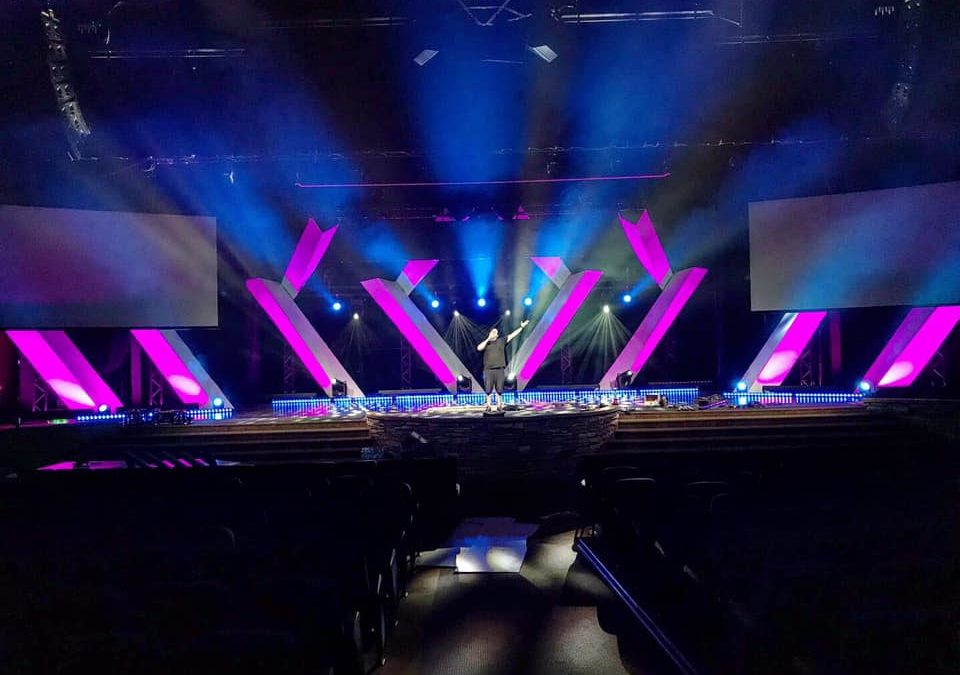Welcome to the Mod Scenes podcast. This is your host, Stephen, and I’m thrilled to chat with you today about reflective surfaces. So, uh, in stage design, uh, in particularly backdrop design, it’s important to have reflective surfaces that you can paint, uh, quote quote-unquote paint with light. Uh, so a reflective surface could be anything from, I mean, everything is reflective to a certain extent, uh, and anything can be painted with light to a certain extent, uh, with the exception of a few things, but not very many stage backdrops. Um, so let’s get, let’s get started on this. So the, um, so what actually spurred this idea of a, a podcast about lighting reflective surfaces is in particular, uh, a stage design I did a few years ago, uh, that was a bunch of aluminum, uh, a bunch of aluminum stage design pieces. So it was a giant screen surround for a corporate event that had aluminum pieces that, that, uh, brushed aluminum pieces that went around the entire, the entire screen surround.
It looked incredible, but it had to be lit somehow, uh, because it was just kind of in a dark area where the screen was setting and had to be lit. Uh, obviously it was in a dark area, so the screen would look nice. Um, but, uh, so we had to light it, but the hard part with that is that, um, whenever you light a reflective surface, like a mirror or like a brushed aluminum, uh, you are going to get, uh, you’re going to get, uh, reflections. So your reflection is going to be the opposite, the universe angle of whatever you’re hitting it from. So if you’re hitting it from a 45 degree from a lighting point, a trust straightened front, it’s going to go to 45 degrees down from the screen into your viewers eyes. So you don’t want to do that. Um, so what we did is we lit everything from one angle.
Uh, we went like 60 degrees off so that, uh, the bounce, wherever it bounced off would shoot into the far wall, um, to the, like to the wall, the air wall that it wasn’t up against. Uh, so whenever you’re, whenever you’re designing with reflective materials, you need to keep that in mind the specifics of how you’re going to need to light it. Um, so, but as I mentioned, most of materials are reflective to some extent with the exception of the space black that will swallow up your face and is really cool. And I want him to get like 30 shirts made of it. Um, other than that most suffers, reflective, even black as reflective depending on the type of material. So, um, let’s start with some common materials that are reflective. So, um, I mentioned that brushed aluminum is super reflective. Another thing that’s really reflective as mirrors, uh, obviously they reflect tons of light reflected images, so they have to be very reflective to, to do that.
Um, uh, so in my experience, mirrors are not a great thing to use a stage design, unless you’re intentionally looking for a more abstract design for your stage backdrops that is playing with bending light. Um, just because you will have lots of shadow, lots of, lots of redirection of the light as you light it. Um, and unless it’s kind of a one trick pony, like you can light it in white or be light in any color, but it’s always going to show up the same. Um, so, um, however, like a brushed aluminum, if you light it, you’re going to get a little bit of coloration. Um, Mylar is very similar. You’re going to get a, if you light it, you’re going to get a little bit of coloration, but it’s still going to reflect, uh, tons of light. Uh, so you have to be careful to, to where, how you’re lighting and where you’re pointing it, and you have to have a lot of intensity to actually get it to look good.
Um, so, uh, let’s see other, uh, other reflective products and services. So, um, obviously plastics are pretty reflective. So plastics, I think hit the best, uh, the best of both worlds. So they’re very reflective, so they bounce a ton of light, but they do so in a controlled manner. And so, and since like we use white plastic for our Mod Scenes and proteins lines. So since we use that white plastic, it takes whatever color we put onto it, um, and says plastics are a really even finished the way that they’re made. They have a very consistent product there. It’s a very consistent product, very consistent, uh, texture, the way it reflects light is really consistent. So it works great for you. So stage design, we are great yet stage backdrops. Uh, that’s why we use, uh, novice plastics for our Mazzi and Anson proceeds product lines.
It just makes sense cause they re they reflect the light best, uh, in the way that makes the most sense for use in stage design, uh, woods are also reflective. What’s do take are typically a warmer, a warmer tone. So if you hit it with light, it’s typically going to look warmer than the actual source light. You’re hitting it from, uh, they also, uh, take a little bit more light to light. So you have to have a little bit more intensity to light them. Well, uh, just because they are a darker color than like a white plastic. Um, let’s see, what else, uh, aluminum screening. So anything that’s metal is going to, um, gonna reflect a lot of light typically, uh, aluminum screening is great though, because whenever you throw a light onto it, uh, you do definitely get, uh, you do definitely get the really refractive properties of like a brushed aluminum or something like that, like a flat sheet of aluminum.
But the thing is those thin lines are so, uh, so densely spread together. So densely packed together yet spread out enough that you don’t see our fluxion off of it. So like you see, you see the light bounce off of it, but you don’t see a reflection if that makes sense. Um, so that’s a great, another great thing for catching some, some light, whenever you’re doing a stage design, um, fabrics are another one that, that, uh, depending on the fabric, you can get a lot of bang for your buck, uh, because you can get a lot of fabrics kind of, uh, like an iridescence, uh, included in like I love, uh, poly shear, cause it’s, it’s just, uh, particularly like an ivory poly sheer, like it looks kind of has a glossy look already and then you add light to it and just looks incredible.
Um, so, um, but again, you always have to remember anytime you’re lighting, uh, lighting a stage backdrop or a stage design that has the super reflective surfaces. If it’s going to be like a mirrored surface, it’s gonna bounce a bounce off in the opposite direction, whereas a textured surface or a really consistent surface, like plastic, isn’t gonna bounce the light off. It’s going to refract the light. So it’ll it’ll instead of bouncing all the light in one direction will bounce in multiple directions. Um, so yeah, so, um, so playing into that, so thinking about our materials while we’re lighting them, and we should always be thinking about if it’s a mirror type material, so a really, uh, really shiny, uh, material that you’d be able to try and let the light on it bounces off. We want to make sure that we’re setting our lights in a way that they don’t blind people.
Uh, if it’s more of a refractive refracting material, like a plastic or aluminum window screening or, uh, a fabric, that kind of stuff, uh, we want to, when you light it, you want to light it from angles where you’re going to get the most impact. Typically a downlight is the easiest. You get a lot of impact and end. It’s a, and it’s relatively easy to do. I try to, for the most part, stay away from lighting things from the front. So like, let’s say like you have a safe backdrop and you walk 10 paces away from it, then shoot a light at it. I try not to do that because typically, um, atypically you’re gonna hit something else in the process for your stage backdrops. So you’re gonna light it light, you know, your singers or somebody else in the process. Uh, but also, uh, you get less intensity and you get less shadowing.
Shadowing is actually one of the great things about, uh, the monsoons products is you can get some great shadowing, uh, by you by shooting lights around the panels. So, uh, you kind of lose that. If you just do a, a light from the front, it feels, it starts to feel really flat. And, uh, it just looks better if you do an applied or downlight or sidelight or a, we’re a combination of all three, all three is ideal because then you can use some at some points and some, you can turn some on some off, you can move those around as needed. Um, that’s one of the things that’s kind of a lost art in the lighting design world is, uh, is being, uh, is using multiple lights, but not necessarily using them all all the time. So as a lighting designer, uh, and scenic designer, when you’re lighting something, at some point you may want, it lit one way at some points you may want to live a different way.
For example, like if I’m trying to communicate a really bright, energetic song, I’m going to use my front lock, my sidelight and my upline and downline to light the scenic. And I’m going to do some sort of contrast in colors. So I get some nice, uh, some nice contrast and I’ll probably do a dimmer effect too. Whereas if I want to have a really somber look, all, do just my floor lights and maybe add in just a touch of the sidelights and a different color, like maybe UV on the floor lights and then a little bit of red from the sides just to make it pop. Um, so that’s, that’s one thing to keep in mind as you’re designing. Like you don’t have to necessarily, you don’t have to design it. Doesn’t have to be everything all on at once. Um, save some of that for a different look, because your best to look like your most energetic look is only as good as your least energetic look.
So if you don’t have something that really breaks it down and makes it, uh, you know, makes it really super, uh, uh, chill, then it’s, you know, if everything’s at a hundred percent, nothing’s going to look like there’s going to be no dynamics. So you want to make sure you build the dynamics of your design, uh, when you’re lighting it and when you’re using those lights and programming those lights. So, um, I hope this has been a helpful podcast about stage design lines and creating great stage backdrops and specifically about lighting those great stage backdrops. Um, if you have any questions, please let me know, can email me@stevenandmozziesdotcomoryoucanvisitusatmodscenes.com and fill out the form there. Thanks again for reaching out to us and thanks for listening to the Mod Scenes podcast. And if there’s any other way we can serve you let us know.


Recent Comments